
John the Apostle or Saint John the Beloved was one of the Twelve Apostles of Jesus according to the New Testament. Generally listed as the youngest apostle, he was the son of Zebedee and Salome. His brother James was another of the Twelve Apostles. The Church Fathers identify him as John the Evangelist, John of Patmos, John the Elder, and the Beloved Disciple, and testify that he outlived the remaining apostles and was the only one to die of natural causes, although modern scholars are divided on the veracity of these claims.

The Holy Lance, also known as the Lance of Longinus, the Spear of Destiny, or the Holy Spear, is the lance that is alleged to have pierced the side of Jesus as he hung on the cross during his crucifixion.
Pierre Plantard de Saint-Clair was a French technical artist, best known for being the principal fabricator of the Priory of Sion hoax, by which he claimed from the 1960s onwards that he was a male-line Merovingian descendant of Dagobert II and the "Great Monarch" prophesied by Nostradamus. Today in France, he is commonly regarded as a con artist.
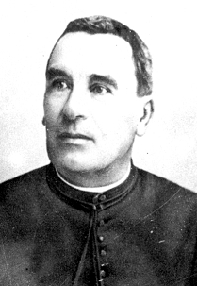
François-Bérenger Saunière was a French Catholic priest in the village of Rennes-le-Château, in the Aude region. He was a central figure in the conspiracy theories surrounding the village, which form the basis of several documentaries and books such as the 1982 Holy Blood, Holy Grail by Michael Baigent, Richard Leigh, and Henry Lincoln. Elements of these theories were later used by Dan Brown in his best-selling 2003 novel The Da Vinci Code, in which the fictional character Jacques Saunière is named after the priest.
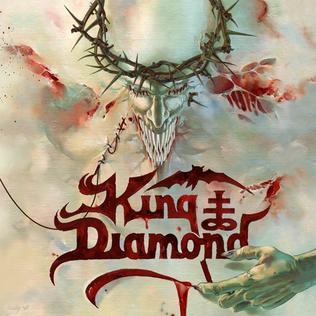
House of God is the ninth studio album by Danish heavy metal band King Diamond, released on 20 June 2000. It is the only album to feature guitarist Glen Drover and bassist Paul David Harbour, and the last to feature drummer John Luke Hébert.
Géraud-Marie de Sède, baron de Liéoux was a French author, writing under the nom-de-plume of Gérard de Sède, and a member of various surrealist organizations. He was born into an aristocratic family from Comminges, the son of Marcel Alfred Gustave de Sède, baron de Liéoux and Aimée de Sède de Liéoux 's first cousins, once removed. De Sède's father was the senior editor of the Catholic newspaper Le Courrier du Pas-de-Calais owned by the De Sède family.
Lynn Picknett is an English writer of books that are mainly about religious history and popular conspiracy theories, the paranormal, the occult, and historical mysteries.
Vernon Dobtcheff is a British actor, best known for his roles on television and film, he has acted in numerous stage productions.

The Da Vinci Code is a 2003 mystery thriller novel by Dan Brown. It is Brown's second novel to include the character Robert Langdon: the first was his 2000 novel Angels & Demons. The Da Vinci Code follows symbologist Robert Langdon and cryptologist Sophie Neveu after a murder in the Louvre Museum in Paris causes them to become involved in a battle between the Priory of Sion and Opus Dei over the possibility of Jesus Christ and Mary Magdalene having had a child together.
The Jesus bloodline refers to the proposition that a lineal sequence of the historical Jesus has persisted, possibly to the present time. The claims frequently describe Jesus as having married, often to Mary Magdalene, and as having descendants living in Europe, especially France but also the UK. Differing and contradictory Jesus progeny scenarios, as well as more limited claims that Jesus married and had children, have been proposed in numerous modern books. Some such claims have suggested that Jesus survived the crucifixion and went to another location such as France, India or Japan.

Gabriel Knight 3: Blood of the Sacred, Blood of the Damned is a point-and-click adventure game, developed and published by Sierra Studios for Microsoft Windows, and released in 1999. The sequel to 1995's The Beast Within: A Gabriel Knight Mystery and the third title in the Gabriel Knight series, the game's story focuses on the lives of Gabriel Knight, an author who is descended from a family that combats supernatural evils, and Grace Nakimura, a student who assists Gabriel, as they become engaged in a case that involves tracking down a kidnapped infant by vampires that is connected to the Holy Grail and Jesus. The setting is based on a real-life conspiracy theory about a hidden treasure, and involves elements of history and myths surrounding the Grail, vampires, and the Knights Templar.

The Last Temptation of Christ is a 1988 epic religious drama film directed by Martin Scorsese. Written by Paul Schrader with uncredited rewrites from Scorsese and Jay Cocks, it is an adaptation of Nikos Kazantzakis' controversial 1955 novel of the same name. The film, starring Willem Dafoe, Harvey Keitel, Barbara Hershey, Andre Gregory, Harry Dean Stanton and David Bowie, was shot entirely in Morocco.
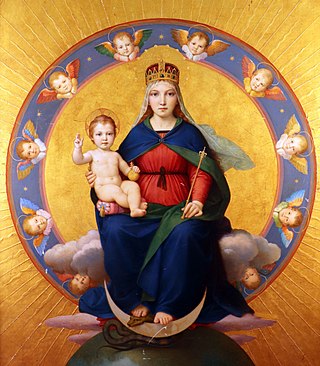
The Woman of the Apocalypse is a figure–often considered to be a reference to the Virgin Mary in Catholic theology–described in Chapter 12 of the Book of Revelation.
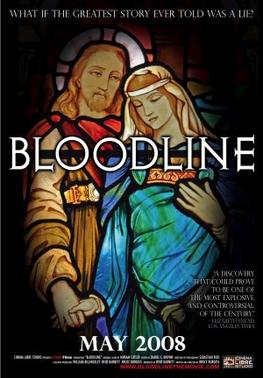
Bloodline is a 2008 documentary film by Bruce Burgess and Rene Barnett, a filmmaker with an interest in paranormal claims, focused on the "Jesus bloodline" hypothesis and other elements of the 1982 book The Holy Blood and the Holy Grail.
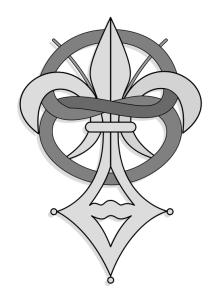
The Prieuré de Sion, translated as Priory of Sion, was a fraternal organization founded in France in 1956 by Pierre Plantard in his failed attempt to create a prestigious neo-chivalric order. In the 1960s, Plantard began claiming that his self-styled order was the latest front for a secret society founded by crusading knight Godfrey of Bouillon, on Mount Zion in the Kingdom of Jerusalem in 1099, under the guise of the historical monastic order of the Abbey of Our Lady of Mount Zion. As a framework for his grandiose assertion of being both the Great Monarch prophesied by Nostradamus and a Merovingian pretender, Plantard further claimed the Priory of Sion was engaged in a centuries-long benevolent conspiracy to install a secret bloodline of the Merovingian dynasty on the thrones of France and the rest of Europe. To Plantard's surprise, all of his claims were fused with the notion of a Jesus bloodline and popularised by the authors of the 1982 speculative nonfiction book The Holy Blood and the Holy Grail, whose conclusions would later be borrowed by Dan Brown for his 2003 mystery thriller novel The Da Vinci Code.

Chinese Roulette is a 1976 West German film written and directed by Rainer Werner Fassbinder. It stars Margit Carstensen, Ulli Lommel, and Anna Karina. The film, a bleak psychological drama, climaxes with a truth-guessing game, which gives the film its title. The plot follows a bourgeois married couple whose infidelities are exposed by their disabled child.
Henry Soskin, better known as Henry Lincoln, was a British author, television presenter, scriptwriter, and actor. He co-wrote three Doctor Who multi-part serials in the 1960s, and — starting in the 1970s — inspired three Chronicle BBC Two documentaries on the alleged mysteries surrounding the French village of Rennes-le-Château — and, from the 1980s, co-authored and authored a series of books of which The Holy Blood and the Holy Grail was the most popular, becoming the inspiration for Dan Brown's 2003 best-selling novel, The Da Vinci Code. He was the last living person to have written for Doctor Who in the 1960s.

The Holy Blood and the Holy Grail is a book by Michael Baigent, Richard Leigh, and Henry Lincoln.
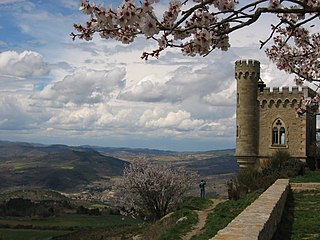
Rennes-le-Château is a commune approximately 5 km south of Couiza, in the Aude department in the Occitanie region in Southern France.
Livre du Saint Sacrement is a collection of pieces for organ on the subject of the Eucharist by the French composer Olivier Messiaen. It was composed mainly in 1984, completed in 1985, and first performed in 1986.













